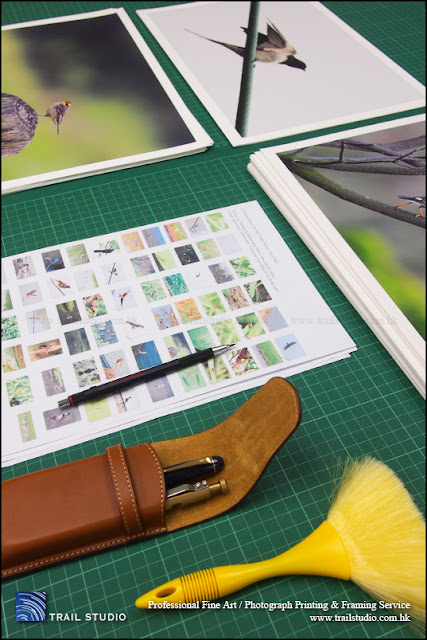香港觀鳥會「跟著港鐵去觀鳥」攝影藝術展
HKBWS Go Bird Watching by MTR Photographic Art Exhibition
香港觀鳥會將於港鐵將軍澳站PopCorn商場舉行攝影藝術展。
香港觀鳥會成立於1957年,是一個旨在欣賞及保育香港鳥類及其自然生態的本地民間組織。2002年,香港觀鳥會更被認可成為一個公共性質的慈善機構。該會舉辦攝影展的一大目的,是透過攝影讓更多人關注自然生態,認真看待保育問題。
很高興Trail Studio能為展覽出一分力,以我們一貫高品質印製相片及作出相關贊助。能參與慈善機構及環保組織的攝影展覽製作,讓我們有機會在自己專業範疇為社會做一些事,同時亦貫徹了當初成立高品質相片工場的信念 - 相片並不只是一個純粹的畫面,而是溝通、保存訊息的工具。而畫質優良的相片,能忠實傳達攝影訊息及藝術風格,從而讓圖片說故事、感染觀賞者。
是次展覽採用我們最高級的啞面Fine Art Paper製作。Fine Art Paper被視為archival-safe的物料,但亦能用於短期室內展覽。使用優質啞面Fine Art Paper展出作品有很多好處,例如:
1. 紙質較一般相紙厚重有質感,無需裱貼於底版也不易起縐
2. 全啞紙面不反光,再配上我們的藝術級輸出設備,可印製出極高色彩層次、極具迫真感的相片。
3. 極有利展出於燈光變化大/光線條件惡劣/無專業佈光之場地時,作品不受反光問題困擾,讓參觀者能多角度觀賞。
4. 同樣原因,使用手機/相機內置閃光燈拍照留念也不必擔心作品畫面變白。
留意,另一種「啞面裱膜相紙」雖然也是「啞面」,但由於是塑膠面,其實是會反光的(只是散射而已),沒有上述優勢。
Fine Art Paper用於短期展覽時一般不會配上玻璃作保護,愛護展品,請勿觸摸。
「跟著港鐵去觀鳥」攝影藝術展詳情如下:
開幕禮日期:2017年6月1日 (星期四)
開幕禮時間:下午3:00至下午3:40
地點:將軍澳PopCorn一期一樓大舞台1 (將軍澳港鐵站商場)
主禮嘉賓:環境局副局長陸恭蕙太平紳士
展覽日期:2017年6月1日至9日(10am-10pm)
展覽內容:「跟著港鐵去觀鳥」攝影教育學員的作品,教育活動以市民最容易接觸的媒介-「攝影」為主題,透過視覺藝術的創意表達,讓市民表達對香港濕地保育的關愛。
Exhibition Details:
Go Bird Watching by MTR Photographic Art Exhibition
Date: 1– 9June 2017
Time: 10:00am – 10:00pm
Venue: 1/F Atrium of PopCorn (Tseung Kwan O MTR Station)
Hong Kong Bird Watching Society 香港觀鳥會: http://www.hkbws.org.hk/
Trail Studio: http://www.trailstudio.com.hk
這是製作相片時拍攝的:
一張張很大張未裁切的藝術紙。
用慢動作,小心地把藝術紙裁成獨立的相片。處理大尺寸紙章時,要保持紙張完好沒有括花、起縐或被污染,不算容易,欲速則不達。
裁好相片後,再排好次序。
最後再檢查一次品質,並點算相片。這也是慢動作步步為營,很花時間的。一不小心弄壞相紙便前功盡廢,不是大家所想那麼容易的。
等待包裝的相片。由於每次的訂單都是不同款色尺寸的,我們根本不能大量訂製包裝物料,個別包裝時要讓製品得到合理保護,又要考慮客戶能否輕易安全地取出相片,用的功夫也不簡單呀。很有趣的,常有不少客戶大讚我們的包裝方式 :)















